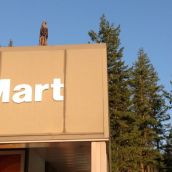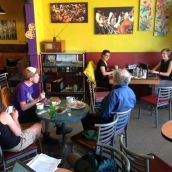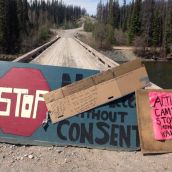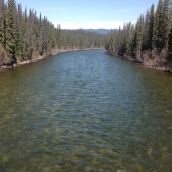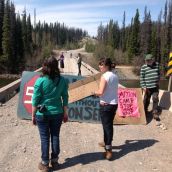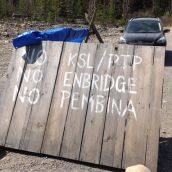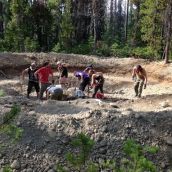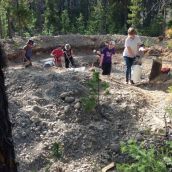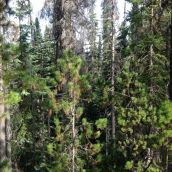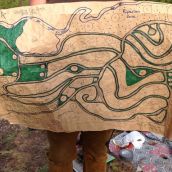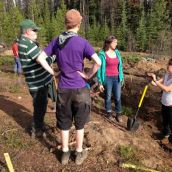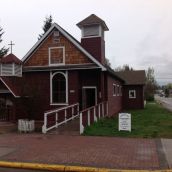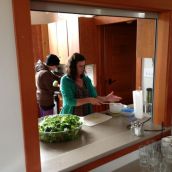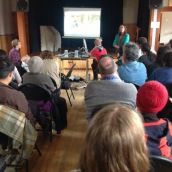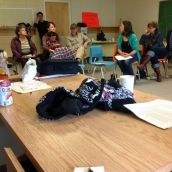PHOTOGRAPHY about IndigenousGovernanceEnvironmentposted on May 29, 2013 by Joseph Jones
Rising Tide Building Resistance Tour Photo Diary – Part I
Kamloops (photos 1-7)
The Rising Tide tour started off with a very active day in Kamloops. High-school-appropriate presentations and activities were shared with a Social Justice 12 class and three other classes, in two different schools. A late-afternoon meet-up with the Kamloops group of Council of Canadians provided an opportunity to exchange concerns and to hear about the potential impacts of the Ajax mine proposal, particular its proximity to Kamloops and its unfavorable siting in relation to prevailing winds. At an evening meeting with Secwepemc near Chase we heard especially about the threat that Ruddock Creek mining of zinc and lead could pose to the headwaters of the Adams River and its famous salmon run. May the hand-carved raptor that watches out from the roof of the store where we parked also deter the destructive resource extractors.
Prince George (photo 8)
On two of the longest driving days (Kamloops to Smithers and Dawson Creek to Vancouver) a bookstore-cafe in Prince George offered a great break from the long road.
Unist'ot'en Camp (photos 9-18)
Our one-day visit to the work camp that was underway on Unist'ot'en territory gave first-timers an opportunity to see how the projects relate to the land. After 66 km of driving on gravel roads from Houston, we reached the Morice River. To cross the bridge, each individual must gain acceptance through the protocol of free, prior, and informed consent. All tour participants who felt physically able contributed to the camp work efforts, whether in construction of a pit-house, in preparing food in the kitchen, or in development of the permaculture garden. The pit-house showed remarkable progress after only four days. The excavation is 30 feet in diameter and will have a four-foot doorway facing eastward. The site occupies high ground, with steep dropoff toward the river. Its location relates to a redrawn Pacific Trails Pipeline route that has sought to bypass the log structure already built close to the river.
Smithers and Burns Lake (photos 19-23)
Rising Tide shared food with and presented to two groups in Smithers and Burns Lake on successive days. Materials had been developed to focus on the trailblazing nature of the Pacific Trails Pipeline, the crucial position of Indigenous peoples on unceded territories in blocking its pathway, the role and dubious impacts of recently developed fracking techniques in boosting "natural gas" (which is mostly methane) production, and the interconnections of apparently separate forms of energy — tar sands bitumen, fracked natural gas, and hydroelectric power. The production and transport of energy resources itself directly consumes huge amounts of energy, and profiting private corporations seek subsidized public inputs.
Smithers displays a home-made billboard that brings home the local economic necessity that arises in most conversation about the health and sustainability of the environment. At the Smithers gathering, one of the land defenders at the Unist'ot'en camp spoke movingly in appreciation of the support that comes from outside, with hopes to see even more local strength develop in response. In Burns Lake, the impact of the January 2012 sawmill fire was apparent among the audience. Grassroots persons there are risking ostracism and even their jobs to stand against a colonialist governance that holds an unannounced meeting to produce skewed approval for undiscussed and likely unsupported decisions.
The site for the Vancouver local of The Media Co-op has been archived and will no longer be updated. Please visit the main Media Co-op website to learn more about the organization.






